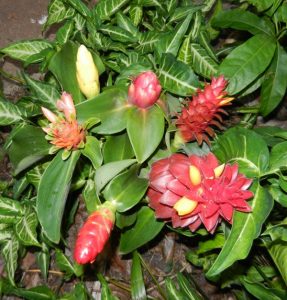For those of you who aren’t ginger flower fanatics, I thought I might introduce you to a group of flowers which are members of the ‘ginger’ family, which, I might add, is huge – a lot of genera and hundreds of species, scattered all over the world. The ones I am thinking of today are the Costus.We grow a few of them as cut flowers because the central cone from which the flowers emerge is brightly coloured and long lasting. The flowers themselves, often very pretty, usually only last for a day or so, and then need to be removed. These dayflowers are not only cute, but edible as well – they make a charming and intriguing addition to the salad bowl. They are fairly crisp, tangy and just a hint of spice and honey, and you can bet your bottom dollar not many people will know them for what they are.
 Costus are very easy to grow, and tolerate a wide range of conditions – full sun to semi-shade, fairly dry to swampish. I have actually seen them growing in quite deep water in a river-edge, although I must say this was at the end of the wet season, and the river flood was going down. But there they were in a metre of water, flowering gaily.
Costus are very easy to grow, and tolerate a wide range of conditions – full sun to semi-shade, fairly dry to swampish. I have actually seen them growing in quite deep water in a river-edge, although I must say this was at the end of the wet season, and the river flood was going down. But there they were in a metre of water, flowering gaily.
They can be reproduced by root or rhizome division – like all gingers, or they can be grown from stem cuttings in the warm weather. These should be cut in lengths 25 – 30 cm, trimmed of their leaves and laid flat in the mulch, or a tray of seed raising mix, and kept damp. In a few weeks new plants will grow from the point where the leaf joined the stem, and as soon as the plantlet has its own roots, it can be detached and potted up, until it is big enough to go out into the garden. Costus will also sometimes grow plantlets from the leaf axils at the base of the flower, which then falls to the ground, so that the new plantlet can grow roots. In this way quite a thicket can grow up.
I grow them in hedges, about two metres tall, very pretty, and almost always covered in flowers. They need to be deadheaded occasionally – each stem only flowers once, so it should be cut off at the base, and discarded. Be careful about putting the trimmings in the compost heap too early though – let them dry out, or you might find you have more plants than you know what to do with.
The photo shows six of the many varieties around – the top pale flower is a yellow variety of Costus spicata, from Belize, next, clockwise, is Costus spiralis ‘Strawberry Bud’, then Costus barbatus I and II, then Costus spicata ‘Indian Head’, and the last is an unknown Costus hybrid called ‘Green Mountain’.
